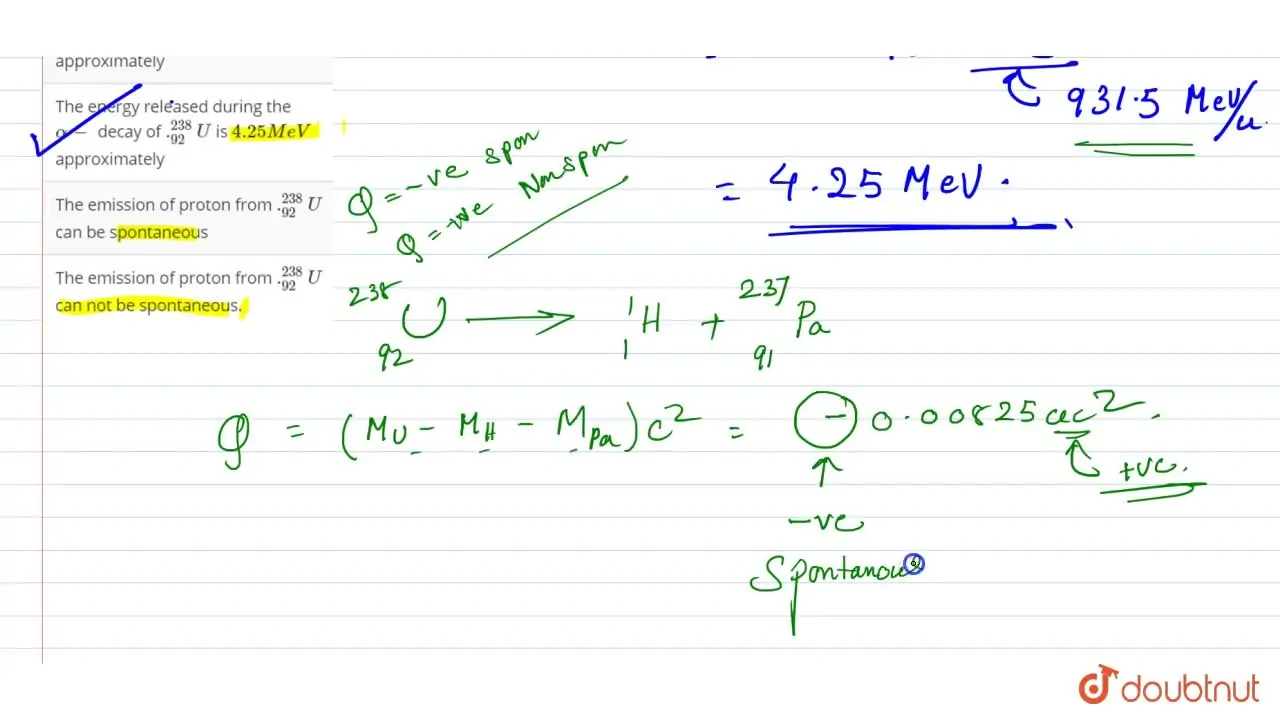We are given the following atomic masses:
.23892U=238.05079u.42He=4.00260u
.23490Th=234.04363u.11H=1.00783u
.23791Pa=237.05121u
Here the symbol Pa is for the element protactinium (Z=91)
The energy released during the α− decay of .23892U is 4.75MeV approximately
The energy released during the α− decay of .23892U is 4.25MeV approximately
The emission of proton from .23892U can be spontaneous
The emission of proton from .23892U can not be spontaneous.
The correct Answer is:B, D
The energy released in α- decay is given by
Q=(MU−MTh−MHe)c2
Substituting the atomic masses as given in the data, we find
Q=(238.05079−234.04363−4.00260)u×c2=(0.00456u)c2=(0.00456u)c2
=(0.00456u)(931.5MeV/u)=4.25MeV
If .23892U spontaneously emits a proton, the decay process would be .23892U→23792Pa+.11H
The Q for this process to happen is
=(MU−MPa−MH)c2=(238.05079−237.05121−1.00783)u×c2=(−0.00825u)c2
=−(0.00825u)(931.5MeV/u)=−7.68MeV
Thus, the Q of the process is negative and therefore it cannot proceed spiontaneously. We will have to supply an energy of 7.68MeV to .23892U nucleus to make it emit a proton.
Related Playlists
- BOOK - FIITJEECHAPTER - TEST PAPERSEXERCISE - PHYSICS747videos
TEST PAPERS
- BOOK - FIITJEECHAPTER - SIMPLE HARMONIC MOTIONEXERCISE - Assignment Problems (Objective) (Level-II)20videos
SIMPLE HARMONIC MOTION
- BOOK - FIITJEECHAPTER - WORK, ENERGY AND POWER EXERCISE - COMPREHENSIONS ( Comprehension-II)5videos
WORK, ENERGY AND POWER
Similar Questions
By using the following atomic masses : .23892U=238.05079u. .42He=4.00260u,.23490Th=234.04363u.
.11H=1.007834,.23791Pa=237.065121u (i) Calculate the energy released during the α−decay of .23892U.
(ii) Show that .23892U cannot spontaneously emit a proton.View SolutionGiven atomic masses are
_92238 U=238.05079u _24He=4.00260u,
_90234Th=234.04363u, _11H=1.00783u.
The energy released during the alpha decay of _92238 U isView SolutionWe are given the following atomic masses:
.92Pu238=238.05079u,
.90Th234=234.04363u,
.91Pa237=237.05121,.1H1=1.00783,
.2He2=4.00260u
(a) Calculate the energy released during α decay of .92U238,
(b) Calculate the kinetic energy of emitted α particles,
(c) show that .94Pu238 cannot spontaneously emit a proton.View SolutionWe are given the following atomic masses:
93Pu238=238.04954u
92U234=234.04096u
2He4=4.00260u
Calculate the kinetic energy associated with the alpha particle emitted during the conversion of 94Pu238 into 92U234View SolutionConsider the following nuclear decay: 23692U→23490Th+X
Determine the amount of energy released in this decay. Use the following atomic masses.
23692=236.045562u,23290Th=232.038054u
42He=4.002603u,10n=1.008665u and 11p=1.007277h
Conversion factors 1u=931.5meV,1eV=1.602×10−19JView SolutionWhich of the following element is an isodiapher of .92Pb212?
a.92U235 b. .90Th231 c. .83Bi209 d. .91Pa231View SolutionShow that 23892U cannot spontaneosly emit a proton. Given :
23892U=238.05079u,23791Pa=237.05121u,11H=1.00783uView SolutionConsider the following nuclear decay: (initially .236U92 is at rest)
.23692→.23290Th→X
Following atomic masses and conversion factor are provided
.23692U=236.045562u,
.23290Th=232.038054u,
.10n=1.008665,.11p=1.007277u,
.42He=4.002603u and
1u=1.5×10−10J
The amount of energy released in this decay is equal to:View SolutionFrom the following nuclei select the isotopes and isobars :
23892U,23490Th,23492U,23491Pa .View SolutionCalculate the amount of energy released during the α-decay of
.23892U→23490Th+.42He
Given: atomic mass of .23892U=238.05079u, atomic mass of .23490Th=234.04363u,
atomic mass .42He=4.00260u,1u=931.5MeV/c2. Is this decay spontaneous?Give reason.View Solution


